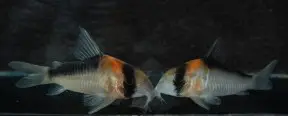Corydoras duplicareus
Etymology
Corydoras: from the Ancient Greek κόρυς (korus), meaning ‘helmet’, and δορά (dora), meaning ‘skin, hide of an animal’, in allusion to the rows of bony plates on the flanks of genus members.
duplicareus: from the Latin duplicare, meaning ‘to double, multiply by two’, in reference to this species’ similarity to the congener C. adolfoi.
Classification
Order: Siluriformes Family: Callichthyidae
Distribution
Known only from a small portion of the upper rio Negro system in Brazil. Type locality is ‘Rio Poranga, 8 kilometers north of the Nobua oba, prior to where it joins a small tributary of the upper Negro River, Brazil’.
Habitat
The type locality contained fast-flowing water and a sandy substrate at time of collection, and this species presumably inhabits pristine blackwater tributaries and areas of flooded forest where the water is characteristically stained dark with organic chemicals.
In the rio Negro basin such habitats typically contain tea-coloured water with very little detectable hardness, low conductivity, and a pH of 4.0-6.0, with other fishes comprising small characids, lebiasinids, and dwarf cichlids of the genus Apistogramma.
Maximum Standard Length
40 – 50 mm.
Maintenance
Ideally use a substrate of fine sand, although rounded gravel is an acceptable alternative provided it’s kept scrupulously clean.
Other décor is largely down to personal choice, but some cover should be provided to give the fish security.
Driftwood branches and dried leaf litter are useful additions, the latter in particular driving establishment of microbe colonies as decomposition occurs.
Such microorganisms can provide a valuable secondary food source for fry, whilst the tannins and other chemicals released by the decaying leaves are also thought beneficial and help simulate natural conditions.
Filtration need only be gentle with an air-powered sponge-style unit normally adequate, although a degree of water movement is acceptable.
Water Conditions
Temperature: 20 – 26 °C
pH: 4.0 – 7.0
Hardness: 18 – 90 ppm
Diet
Corydoras spp. are foraging omnivores and will accept most sinking dried foods, as well as small live and frozen varieties such as chironomid larvae (bloodworm), Tubifex, etc.
Feeding a varied diet will ensure the fish are in optimum condition.
Under no circumstances should they be expected to survive on ‘left-overs’ from other inhabitants of the aquarium or relied on to ‘clean’ the aquarium.
Behaviour and CompatibilityTop ↑
Peaceful and gregarious. Should be maintained in a group of at least 4-6 individuals.
Sexual Dimorphism
Females tend to grow larger, and sexually mature individuals are noticeably rounder and broader-bodied than males, especially when gravid.
Reproduction
Reported to deposit eggs either on the substrate or around the water line.
NotesTop ↑
This species is among a number of congeners native to the rio Negro region to possess a colour pattern with an oblique dark bar running along the dorsal surface of the body.
This unofficial group also includes C. burgessi, C. davidsandsi, C. duplicareus, C. imitator, C. melini, and C. serratus, and among these C. duplicareus is most easily-confused with C. adolfoi.
The oblique dark body bar tends to be less broad in C. adolfoi, and the orange patch of pigment on the nape less intense than in C. duplicareus, but these characters cannot be used to separate the species reliably.
C. duplicareus does possess serrations on the posterior edge of the pectoral-fin spine which are lacking in C. adolfoi, but these are almost impossible to see with the naked eye.
The genus Corydoras is among the largest catfish groups and currently contains over 150 valid species.
It is included in the family Callichthyidae, of which members are often referred to collectively as ‘armoured’ or ‘mailed’ catfishes group due to the presence of bony plates in place of scales on the body.
Their taxonomy can be confusing, and numerous undescribed species are also thought to exist.
Fish of unconfirmed identification entering the aquarium hobby are therefore typically assigned a ‘C‘ or ‘CW‘ number for purposes of reference and organisation.
They are facultative air breathers and possess a modified, highly vascularised intestine which has evolved to facilitate uptake of atmospheric oxygen and aid survival in oxygen-deprived environments. In the aquarium you’ll occasionally see them rising to the surface to take in gulps of air.
The stiffened pectoral-fin spines are capable of piercing human skin and a ‘sting’ can be very painful indeed, so care should be exercised when handling them.
It is thought that secretions from the axillary glands at the base of each spine may even be mildly toxic or venomous.
References
- Sands, D. D., 1995 - Freshwater and Marine Aquarium 18(7): 8-12, 14, 16, 18
Four new Corydoras (Callichthyidae) species from Upper Negro River tributaries and a range extension, together with a discussion of C. bicolor Nijssen & Isbrücker. - Ferraris, C. J., Jr., 2007 - Zootaxa 1418: 1-628
Checklist of catfishes, recent and fossil (Osteichthyes: Siluriformes), and catalogue of siluriform primary types. - Fuller, I. A. M., and H-G. Evers, 2005 - Verlag A.C.S. GmbH: 1-384
Identifying Corydoradinae Catfish. - Reis, R. E., S. O. Kullander, and C. J. Ferraris, Jr. (eds) , 2003 - EDIPUCRS, Porto Alegre: i-xi + 1-729
Check list of the freshwater fishes of South and Central America. CLOFFSCA.






November 8th, 2013 at 12:39 pm
Sorry, i’m a litte confused.
In the habitat section it says blackwater very acid, in the waterconditions it says pH 6.4-7.4, wich is not (so) acid
November 8th, 2013 at 12:48 pm
Hi Jacco thanks for pointing this out and apologies – it’s one of the old profiles that still requires editing. Think a range of 4.0-7.0 would be more appropriate and will get it fixed soon.
November 21st, 2013 at 10:52 pm
Hi Matt,
thx!